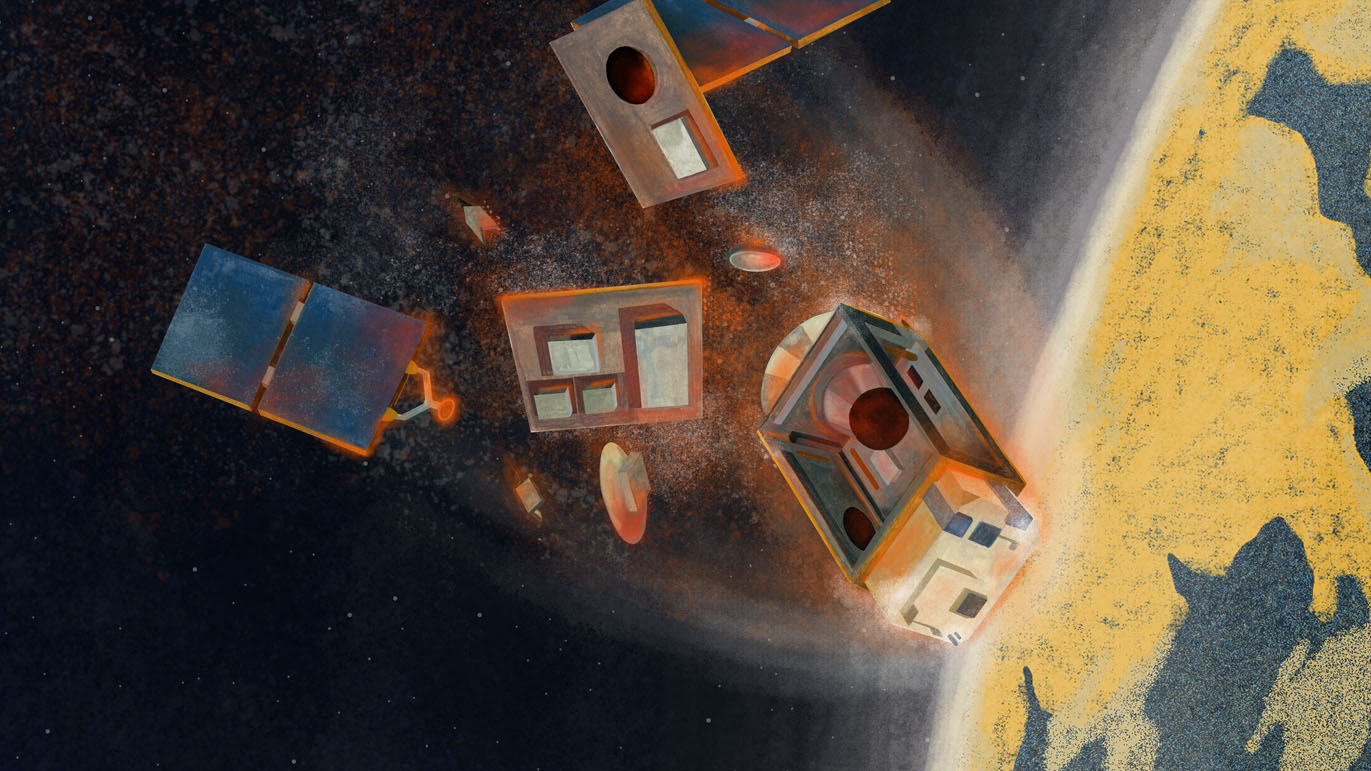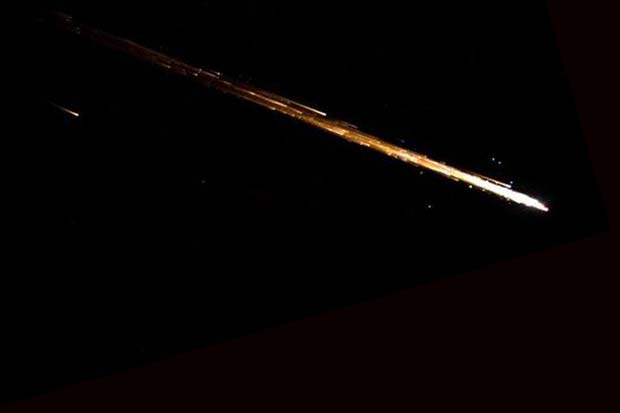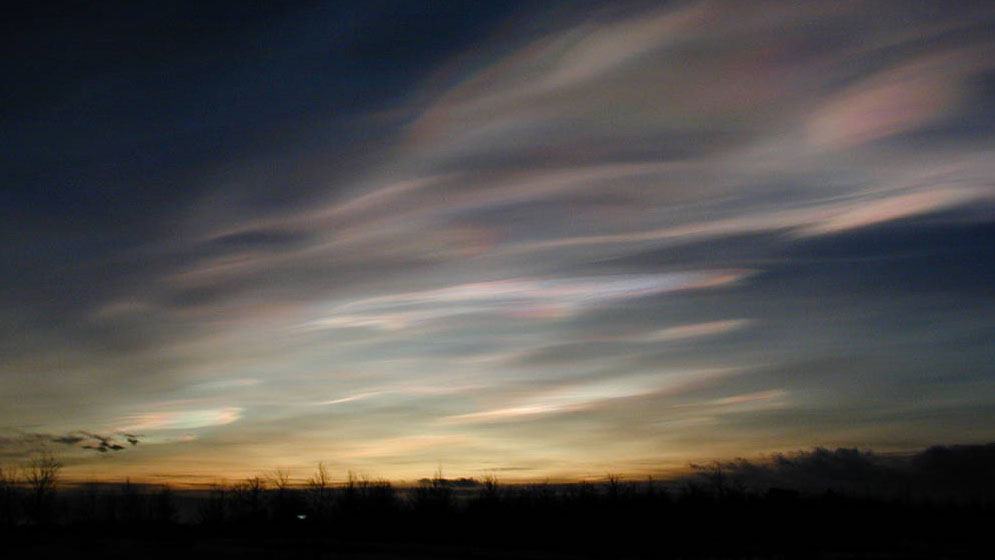Air pollution from reentering megaconstellation satellites could cause ozone hole 2.0
When defunct satellites burn in the atmosphere, they leave behind chemicals that could damage the ozone layer and affect how much light Earth absorbs.

Chemicals released as defunct satellites burn in the atmosphere could damage Earth’s protective ozone layer if plans to build megaconstellations of tens of thousands of satellites, such as SpaceX's Starlink, go ahead as foreseen, scientists warn.
Researchers also caution that the poorly understood atmospheric processes triggered by those chemicals could lead to an uncontrolled geoengineering experiment, the consequences of which are unknown.
For years, the space community was content with the fact that the amount of material that burns in the atmosphere as a result of Earth's encounters with meteoroids far exceeds the mass of defunct satellites meeting the same fate. Even the rise of megaconstellations won't change that. The problem, however, is in the different chemical composition of natural meteoroids compared to artificial satellites, according to Aaron Boley, an associate professor of astronomy and astrophysics at the University of British Columbia, Canada.
"We have 54 tonnes (60 tons) of meteoroid material coming in every day," Boley, one of the authors of a paper published May 20 in the journal Scientific Reports, told Space.com. "With the first generation of Starlink, we can expect about 2 tonnes (2.2 tons) of dead satellites reentering Earth's atmosphere daily. But meteoroids are mostly rock, which is made of oxygen, magnesium and silicon. These satellites are mostly aluminum, which the meteoroids contain only in a very small amount, about 1%."
Related: SpaceX's Starlink satellite megaconstellation launches in photos
Uncontrolled geoengineering
The scientists realised that megaconstellations have a significant potential to change the chemistry of the upper atmosphere compared to its natural state. But not only that. The burning of aluminum is known to produce aluminum oxide, also known as alumina, which can trigger further unexplored side effects.
"Alumina reflects light at certain wavelengths and if you dump enough alumina into the atmosphere, you are going to create scattering and eventually change the albedo of the planet," Boley said.
Get the Space.com Newsletter
Breaking space news, the latest updates on rocket launches, skywatching events and more!
Albedo is the measure of the amount of light that is reflected by a material. In fact, increasing Earth's albedo by pumping certain types of chemicals into the higher layers of the atmosphere has been proposed as a possible geoengineering solution that could slow down global warming. However, Boley said, the scientific community has rejected such experiments because not enough is known about their possible side effects.
"Now it looks like we are going to run this experiment without any oversight or regulation," Boley said. "We don't know what the thresholds are, and how that will change the upper atmosphere."

Ozone hole 2.0
The aluminum from re-entering satellites also has a potential to damage the ozone layer, a problem well known to humanity, which has been successfully solved by widespread bans on the use of chlorofluorocarbons, chemicals used in the past in aerosol sprays and refrigerators.
In their paper, Boley and his colleague Michael Byers cite research by their counterparts from the Aerospace Corporation, a U.S. non-profit research organization, which identified local damage to the planet's ozone layer triggered by the passage of polluting rockets through the atmosphere.
"We know that alumina does deplete ozone just from rocket launches themselves because a lot of solid-fuel rockets use, or have, alumina as a byproduct," Boley said. "That creates these little temporary holes in the stratospheric ozone layer. That's one of the biggest concerns about compositional changes to the atmosphere that spaceflight can cause."
The ozone layer protects life on Earth from harmful UV radiation. The depletion of ozone in the stratosphere, the second lowest layer of the atmosphere extending between altitudes of approximately 7 to 40 miles (10 to 60 kilometers), led to an increased risk of cancer and eye damage for humans on Earth.
Gerhard Drolshagen, of the University of Oldenburg, Germany, who has published papers about the effects of meteoroid material on Earth, told Space.com that reentering satellites usually evaporate at altitudes between 55 and 30 miles (90 and 50 km), just above the ozone-rich stratosphere. However, he added, the particles created as a result of the satellites' burning will eventually sink to the lower layers.
Boley said that as the alumina sinks into the stratosphere, it will cause chemical reactions, which, based on existing knowledge, will likely trigger ozone destruction.
Drolshagen, who wasn't involved in the recent study, agreed that because "satellites are mostly made of aluminum, the amount of aluminum deposited in the atmosphere will certainly increase."
Concerns about the effects of aluminium oxides on the atmosphere have been cited by U.S. telecommunications operator Viasat in its request to the US Federal Communications Commision to suspend launches of SpaceX's Starlink megaconstellation until a proper environmental review of its possible impacts is conducted.

Learning from past mistakes
In their study, Boley and his colleagues looked only at the effects of the first generation of the Starlink megaconstellation, which is expected to consist of 12,000 satellites. More than 1,700 of these have already been launched. As a result of SpaceX's activities (and to a lesser extent those of other constellation operators), the number of active and defunct satellites in low Earth orbit, the region of space below the altitude of 620 miles (1,000 km), has increased by 50% over the past two years, according to the paper.
"The problem is that there are now plans to launch about 55,000 satellites," Boley said. "Starlink second generation could consist of up to 30,000 satellites, then you have Starnet, which is China's response to Starlink, Amazon's Kuiper, OneWeb. That could lead to unprecedented changes to the Earth’s upper atmosphere."
Megaconstellation operators, inspired by the consumer technology model, expect fast development of new satellites and frequent replacement, thus the high amount of satellites expected to be burning in the atmosphere on a daily basis.
"Humans are exceptionally good at underestimating our ability to change the environment," said Boley. "There is this perception that there is no way that we can dump enough plastic into the ocean to make a difference. There is no way we can dump enough carbon into the atmosphere to make a difference. But here we are. We have a plastic pollution problem with the ocean, we have climate change ongoing as a result of our actions and our changing of the composition of the atmosphere and we are poised to make the same type of mistake by our use of space."

Astronomers, space debris and the others
Megaconstellations cause serious worries to the space community as they increase the risks of orbital collisions in the already cluttered orbital environment.
SpaceX's Starlink in particular came under fire also due to the effects the visible trains of their satellites have on astronomical observations. SpaceX pledged to cooperate with the astronomical community and modify the design of their satellites to mitigate the problem. However, earlier this year, the International Astronomical Union asked a specialised United Nations' committee to protect the pristine night sky against light pollution from megaconstellations.
Last week, the chief of European launch provider ArianeSpace, Stephane Israel, accused SpaceX mastermind Elon Musk of monopolizing space and squeezing out competitors.
In addition to SpaceX, Musk also gained recognition with his sustainability-focused ventures Tesla and Solar City, the goal of which was to help wean the world off fossil fuels. Earlier this year, Musk launched the $100 million Carbon Removal X Prize, the richest incentive prize in history. The prize's goal is to develop technologies that can help stave off the worst effects of human-caused climate change.
SpaceX didn’t respond to Space.com’s request for comment.
Follow Tereza Pultarova on Twitter @TerezaPultarova. Follow us on Twitter @Spacedotcom and on Facebook.
Join our Space Forums to keep talking space on the latest missions, night sky and more! And if you have a news tip, correction or comment, let us know at: community@space.com.

Tereza is a London-based science and technology journalist, aspiring fiction writer and amateur gymnast. Originally from Prague, the Czech Republic, she spent the first seven years of her career working as a reporter, script-writer and presenter for various TV programmes of the Czech Public Service Television. She later took a career break to pursue further education and added a Master's in Science from the International Space University, France, to her Bachelor's in Journalism and Master's in Cultural Anthropology from Prague's Charles University. She worked as a reporter at the Engineering and Technology magazine, freelanced for a range of publications including Live Science, Space.com, Professional Engineering, Via Satellite and Space News and served as a maternity cover science editor at the European Space Agency.









